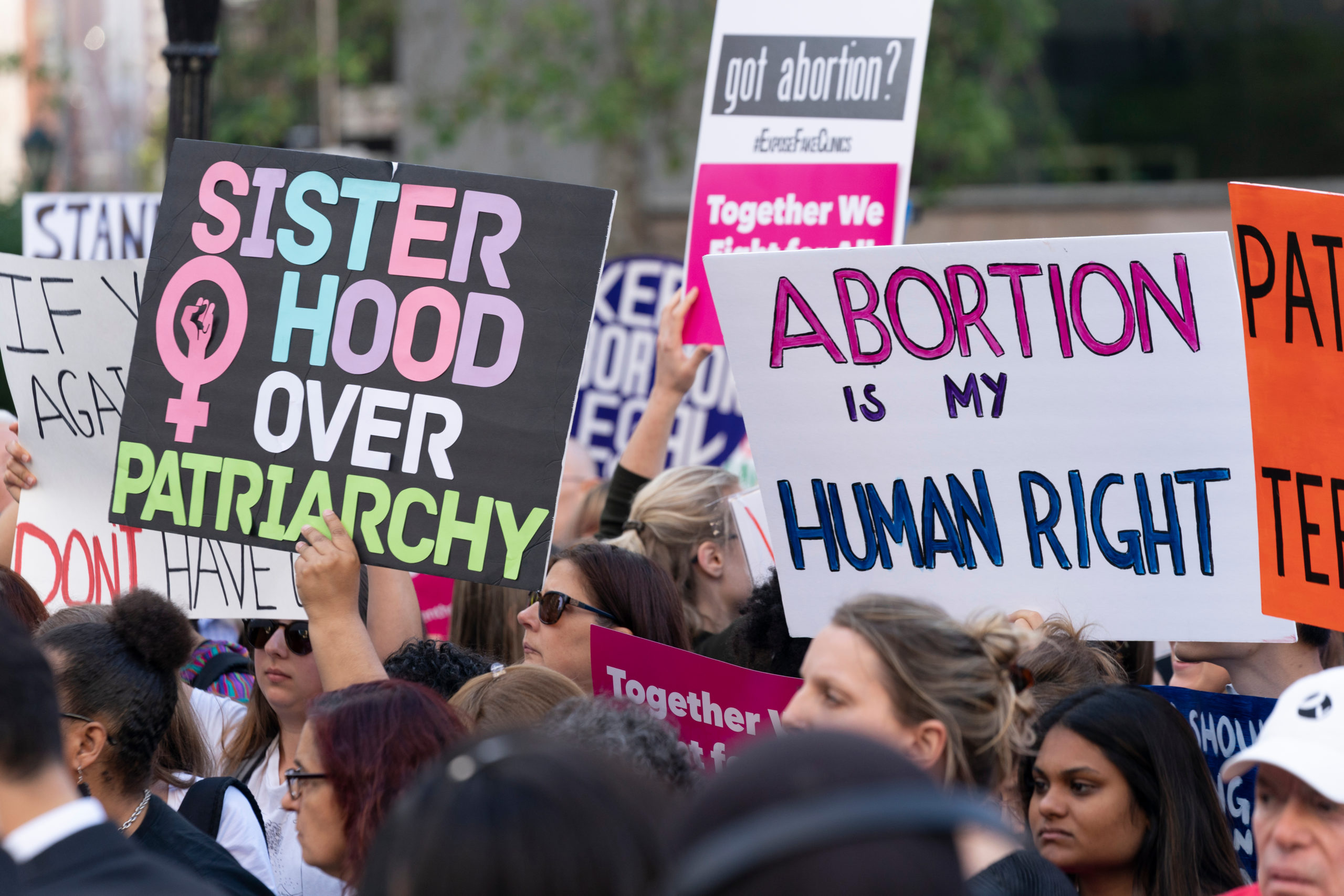October 4, 2022
Gender, Generation and Abortion: Shifting Politics and Perspectives After Roe
Findings from August 2022 American Perspectives Survey

Midterm elections that feature an unpopular incumbent president, acute feelings of economic discontent, and widespread pessimism about the future are not usually close contests. The party in power nearly always loses seats under these conditions. While Democrats are projected to lose their majority in the House of Representatives, the picture in the Senate is less clear. Recent polls in some of the most hotly contested races have found Democratic candidates pulling even or slightly ahead of their Republican opponents in generic ballot tests. Even if polls are exaggerating public support for Democratic candidates as some suggest, the electoral fortunes of the Democratic candidates in individual races and nationally are better than one might expect given political fundamentals. Abortion may be an important reason.
Three months after the Supreme Court overturned Roe v. Wade, the issue of abortion continues to garner widespread public attention. Most Americans are still following news about abortion laws and regulations. In fact, they are paying far more attention to the issue than to the 2022 election itself. Over the summer, Gallup found spontaneous mentions of abortion as the “most important problem” facing the country reaching record highs.[i]
But after the Dobbs v. Jackson Women’s Health Organization decision, concerns about abortion have become more politically lopsided. Democrats are far more likely to say the issue is a priority for them, and they are paying much closer attention to news about emerging legislation than Republicans are. Nearly half of Democrats say abortion is critically important to them, while fewer than one in three Republicans say the same. Not only that, Democrats are more likely than Republicans to say they will only vote for a candidate who shares their views on abortion—a notable change from the past.
At the same time, it’s not clear that the abortion issue will define the 2022 midterm elections. Relatively few Americans—roughly one in three—say abortion is a critical issue. Inflation and crime rank much higher among the public’s concerns. It is also not clear that young women, who feel most passionately about the issue, will turn out to vote in greater numbers than in the past. And for most Americans, abortion is still one among many important issues on which they will judge a candidate.
Still, the Dobbs decision may have an even larger impact in years to come. It may be a distinctive generational coming-of-age moment for many young women, and it may come to define their politics and worldview going forward. Polls show their attitudes on this and other issues are remarkably different from other Americans, including young men.
Today, no issue is more important for young women than abortion. It ranks higher than inflation, crime, climate change, immigration, gun policy, education, and jobs and the economy. What’s more, young women overwhelmingly say abortion should be legal—including nearly half who say there should be no restrictions on it. Finally, young women are more likely than other Americans to say abortion is a defining issue for their vote.
Abortion and the 2022 Election
As the 2022 campaign comes down to the wire, abortion remains a potentially important voting issue in the wake of the Supreme Court’s decision to overturn Roe v. Wade. While concerns about inflation trump all other issues, a growing number of Democrats say abortion is critically important to them. This is especially true for young women. But, at least at this stage of the campaign, younger voters are still much less committed to voting in November and paying less attention to election news.
News About Abortion Laws, the Election, and Inflation
Even as gas prices fall, inflation and gas prices remain an important issue for most Americans. Seventy-five percent of Americans say they are following news about inflation and gasoline prices very or fairly closely. Six in 10 (60 percent) Americans say they are following news about abortion laws and restrictions closely, while less than half (46 percent) say they are following news about the midterm elections closely.
Regarding news about abortion laws, men and women report similar levels of interest. Fifty-nine percent of men and 62 percent of women say they are following news about abortion laws and regulations at least fairly closely. However, there is a substantial gender division among young adults; 64 percent of young women say they are following news related to abortion closely, compared to less than half (46 percent) of young men.
There is a notable partisan division in how closely Americans are following abortion in the news. Seventy-two percent of Democrats and 59 percent of Republicans say they are following news about abortion laws and restrictions fairly or very closely. Notably, with the 2022 elections, Democratic and Republican voters register similar levels of interest.
Abortion Is Not a Critical Concern for Most Americans
Despite attracting significant attention, abortion is not a top-tier issue for most Americans. Economic concerns, in this case “increasing costs of housing and everyday expenses,” topped the list of nine issues in the August American Perspectives Survey. Fifty-six percent of Americans say inflation is a critical issue for them personally, followed by 45 percent who say gun policy is a critical concern and nearly as many (44 percent) who mention crime. What students are taught in schools is a critical issue for 39 percent of the public, followed by abortion and climate change, both at 36 percent. Notably, Americans are not much more likely to say abortion is a critical issue today than they were a year earlier, when 33 percent said abortion was a critical issue.[ii]
However, the partisan gap on views about the importance of abortion has increased dramatically. Democrats are now far more likely than Republicans to say abortion is critically important to them (49 percent vs. 28 percent, respectively). Last year, Republicans and Democrats were about equally as likely to say abortion was a critical concern (36 percent vs. 37 percent, respectively).[iii]
After Roe, a double-digit gap has emerged between men and women on the importance of abortion, a larger gender divide than on any other issue. In the past, there was little difference in men’s and women’s views on abortion.[iv] But today, women prioritize the issue far more than men do. Forty-four percent of women, compared to 28 percent of men, describe abortion as a critical issue for them personally. There is an equally large gap between Democratic men and women on abortion; 39 percent of the former, compared to 56 percent of the latter, say abortion is a critical issue. Among Republicans, women are also somewhat more likely to prioritize the issue than men are (34 percent vs. 23 percent, respectively).
Young Women and the Importance of Abortion
Although abortion does not rank as a top priority for most Americans, it is a far greater priority for young women (age 18–29). Young women are more likely to say abortion is more of a critical concern than they are for any other issue. More than six in 10 (61 percent) young women say abortion is critically important to them. Fifty-eight percent of young women say inflation is critically important, while fewer mention climate change (47 percent), gun policy (44 percent), crime (37 percent), or jobs and unemployment (33 percent).
Young women are also far more likely than older women to prioritize the issue of abortion. Less than half (44 percent) of women age 30 to 49, fewer than four in 10 women age 50 to 64 (38 percent), and roughly one in three (34 percent) women age 65 or older say abortion is a critical issue.
Abortion and Vote Preference
The question of likelihood of voting in the upcoming 2022 election showed a familiar pattern, with older voters being much more likely to participate than younger ones. Seventy-three percent of voters 65 years or older were absolutely certain they would vote, compared to 35 percent of young adults (age 18–29). Almost three times as many younger voters said there was less than a 50 percent chance they would vote (14 to 5 percent).
There is parity in voting intention between Democrats and Republicans. Roughly six in 10 Democratic voters (60 percent) and Republican voters (62 percent) say they are absolutely certain to vote; only 49 percent of independent voters report being absolutely certain.
At this stage of the campaign, Democrats have a slight edge on the generic ballot over Republicans. Thirty-eight percent of registered voters say they would vote for the Democratic candidate, while 34 percent say they would vote for the Republican candidate in their district. However, nearly one in four (23 percent) registered voters say they are not sure they are going to vote or say they are confident they will not be voting in the fall. Democratic candidates have a slight edge with independent voters (31 percent to 24 percent), although a plurality (40 percent) say they are supporting some other candidate or remain uncertain about whom they might support.
Young people are much less likely than older Americans to say they would cast a ballot for the Republican candidate in their district. However, there is a considerable gender divide among young people in their candidate preferences. Young female voters prefer the Democratic candidate over the Republican candidate by more than a 20-point margin (43 percent vs. 19 percent), while young male voters are evenly divided in their support for Republican and Democratic candidates (34 percent vs. 34 percent).
Not only is abortion not a critical concern for most Americans, but relatively few say they would be unwilling to support a candidate whose position on the issue differed from their own. Only 26 percent of Americans say they would only vote for a candidate who shared their views on the issue, while 53 percent say a candidate’s position would be just one of many important factors in their vote decision, and 18 percent do not see abortion as a major issue.
In May 2022, after the leak of the Supreme Court’s Dobbs decision but before the final decision was issued, a Gallup poll found nearly identical results: 27 percent said they could not support a candidate whose views on abortion were different from their own.[v] A majority (54 percent) said a candidate’s position on abortion was one among many important issues, and 16 percent said it was not an important consideration.[vi]
Democrats are more likely than Republicans to describe themselves as single-issue voters on abortion (36 percent vs. 23 percent, respectively), although for most Democrats and Republicans, abortion remains one issue among many. There are no significant differences between Democratic men and women: 34 percent of Democratic men and 37 percent of Democratic women say they would not vote for a candidate they disagree with on abortion. Fewer Republican men (23 percent) and Republican women (24 percent) say the same.
One-third of young adults are single-issue abortion voters, roughly 10 points higher than 50- to 64-year-olds and those 65 or older. Young women are almost 10 points more likely than young men to say they would not support a candidate they disagreed with on abortion (37 percent vs. 29 percent, respectively).
Abortion: Legality, Morality, and Identity
American attitudes on abortion have been measured more often and differently than most any other public policy questions.[vii] Despite this regular polling, attitudes have been relatively stable over time. Over the past 30 years, Americans have generally supported a policy of legal abortion with some degree of restrictions placed on it.
Today, Americans who believe abortion should be legal under any circumstances (35 percent) are three times the size of those who feel it should be illegal in all circumstances (12 percent). But half of the respondents, 50 percent, still put themselves in a middle category: legal only under certain circumstances. Among those who say abortion should be legal only under certain circumstances, more say it should be legal only in a few circumstances (38 percent) than under most circumstances (61 percent).
In the past couple of years, there has been a modest increase in public support for making abortion legal under any circumstances. In 2020, 29 percent of the public said abortion should be legal under any circumstances.[viii]
Young women stand out in their strong support for legal abortion without any restrictions. Nearly half (48 percent) of young women believe abortion should be legal under any circumstance. In contrast, only about one-third of young men (34 percent) and an identical number of senior women (34 percent) say abortion should be legal without restrictions.
Democratic men and women did not differ substantially on the question, with majorities of both groups (55 percent and 59 percent, respectively) saying it should be legal under all circumstances. A chasm separates them from Republican men and women; 12 and 17 percent, respectively, say abortion should be legal in all circumstances. Notably, only one in five (20 percent) Republicans, including roughly equal numbers of men and women (19 percent of men and 22 percent of women), say abortion should be illegal in all circumstances.
The Morality Divide on Abortion
Americans are evenly divided over whether abortion is morally acceptable or wrong. Roughly four in 10 say abortion is always morally acceptable (15 percent) or acceptable most of the time (25 percent). Roughly the same number of Americans say abortion is always morally wrong (15 percent) or wrong most of the time (29 percent). Fourteen percent of the public say abortion is not a moral issue at all.
Even among partisans, few say abortion is always morally right or morally wrong. Roughly one in four (26 percent) Democrats say abortion is always morally acceptable, while 34 percent say it is morally acceptable most of the time. Among Republicans, an identical number say abortion is always morally wrong, and 43 percent say it is wrong most of the time.
Overall, there is not a large gender divide in views about the morality of abortion—in fact, the views of men and women are nearly identical. However, young women and men have distinctly contrasting views on the issue. More than half of young women say abortion is morally acceptable all the time (23 percent) or most of the time (29 percent). In contrast, more than one in three young men say abortion is acceptable always (16 percent) or most of the time (20 percent). Nearly half of young men say abortion is morally wrong most of the time or all the time.
A “Complicated” Issue
Most Americans believe abortion is complicated as opposed to being simple and straightforward. Fifty-three percent of the public say abortion is a complex issue, while less than half (45 percent) say it is straightforward. However, more Americans believe the issue is simple than did a few years earlier. In 2018, more than six in 10 (62 percent) Americans said they thought abortion was a complicated issue.[ix]
Perhaps because of the more liberal attitudes young women hold on abortion generally, they are much more inclined to see abortion as simple and straightforward as opposed to complicated. Young women are divided evenly about whether abortion is complicated or straightforward (49 percent vs. 49 percent, respectively). Among women, a majority of all other age groups believe the issue is complicated.
There is a strong connection between views about the morality of abortion and perceptions of whether it is a simple or complicated issue. Nearly three-quarters (73 percent) of Americans who say abortion is always morally acceptable say the issue is simple and straightforward. In contrast, only 38 percent of those who say abortion is morally acceptable most of the time say it is a simple issue. The pattern is similar among those who say abortion is morally wrong.
Pro-Choice, Pro-Life, or Both?
The “pro-choice” and “pro-life” labels are commonly used to shorthand American abortion attitudes. Yet American affinity for these traditional labels is somewhat more complicated than binary forced-choice questions allow, and they do a relatively poor job of reflecting American attitudes on abortion. Today, many Americans identify with both the pro-choice and pro-life labels or reject both. One-third (33 percent) of Americans say both labels describe them at least somewhat well, while 9 percent say neither label represents them. One in three (33 percent) Americans identify as pro-choice but not pro-life, while more than one in four (26 percent) say the reverse—that they identify as pro-life but not pro-choice.
A significant number of Americans express views on abortion that do not align with the traditional understanding of abortion labels. More than one-third (36 percent) of Americans who identify as pro-life believe abortion should be available in all or most circumstances. Similarly, more than one in five (22 percent) Americans who identify as pro-choice say abortion should be available only in a few circumstances or not at all.
American Society After Roe
When the Supreme Court overturned Roe v. Wade, it upended the 50-year status quo that kept the issue out of the national spotlight and off political agendas. Now, as public interest in the issue has spiked, corporations, places of worship, and elected officials have to adapt to the rapidly evolving political terrain. Americans are now more likely to believe the Supreme Court decisions are influenced by politics and religious beliefs, while few want corporations wading into public debates over abortion access.
Views of Supreme Court Decision-Making
Although the Supreme Court is charged with interpreting the law impartially, most Americans believe that justices are guided as much or more by their personal political views and religious convictions than their understanding of constitutional issues and case law. More than six in 10 (61 percent) Americans say that justices are guided “a lot” by their political views when rendering decisions on particular cases. Nearly half (48 percent) the public believe that justices’ religious beliefs inform their decision-making. Fewer than four in 10 (39 percent) Americans believe that the understanding of constitutional issues and relevant cases has a lot of influence on how justices rule. Few Americans believe that decisions are influenced by public opinion. Only 13 percent of Americans say the views of the public have significant influence over Court decisions.
In the wake of high-profile Supreme Court cases affirming religious liberty rights and more recently the Dobbs ruling, Americans increasingly perceive religious motives in Supreme Court decisions. In 2013, only 37 percent said that the justices’ religious beliefs played an important role in influencing decisions, 11 points lower than today. Americans perceive that personal political beliefs play a somewhat larger role in Supreme Court decisions as well, although the shift has been much more modest. In 2013, a majority (55 percent) of Americans said that the justices’ personal political beliefs guided Supreme Court decisions.[x]
Democrats and Republicans have starkly different views about what most influences Supreme Court decisions. Republicans are more likely to say an understanding of the Constitution and relevant case law (54 percent), rather than personal political views (47 percent) or religious beliefs (30 percent), is a major influence on Supreme Court decision-making. In contrast, more than two-thirds of Democrats say the justices’ political views (78 percent) and religious convictions (68 percent) exercise a lot influence over how justices rule, while only 28 percent say an appreciation of the constitutional and legal issues does.
Views about the sources of influence over Supreme Court decision-making have polarized over the past decade. In 2013, equal numbers of Republicans (56 percent) and Democrats (56 percent) said justices were influenced by their own political views “a lot” in making decisions.[xi] Today, there is more than a 30-point gap between Democrats’ and Republicans’ views.
Disagreement and Compromise
Despite the strong feelings many Americans have about the issue of abortion, most believe it is important to try and understand the beliefs of people who disagree with them. More than half (53 percent) of Americans say that the best thing to do when someone disagrees with you about abortion is to try to better understand their point of view. Roughly four in 10 (38 percent) Americans say it is better to avoid discussing the issue at all, and only 7 percent believe trying to persuade the person to change their mind is the best course of action.
Reflecting the public’s nuanced views on the issue, most Americans believe compromising on the issue of abortion is possible. A majority (58 percent) of Americans believe it is possible to find common ground and compromise on abortion, while 40 percent say this is not possible.
Americans who express more conflicted or nuanced views of abortion—they say it should be legal but with at least some limitations—are most likely to believe compromise is possible. Seven in 10 (70 percent) believe reaching a compromise on abortion is possible. However, more than half (54 percent) of Americans who believe abortion should be legal under any circumstance say it is possible to find common ground on the issue as well.
Americans who say abortion should always be illegal do not believe compromise is possible. Only one in four (26 percent) say Americans can find common ground on the issue. Nearly three-quarters (73 percent) reject it.
Should Corporations and Churches Publicly Address Abortion?
Americans are generally comfortable with corporations and businesses speaking out on a variety of issues, with some important exceptions. More than six in 10 Americans say that businesses should speak out on the issues of poverty (69 percent), racism and racial inequality (63 percent), and climate change (63 percent). The public is more divided over whether businesses should get involved in debates over gun policy (52 percent) and LGBTQ rights (45 percent). Only 39 percent of Americans say corporations should publicly engage on the abortion issue. A majority (58 percent) of Americans say they should avoid getting involved.
Regarding churches and places of worship, Americans agree that they should address poverty (77 percent) and racism or racial inequality (66 percent). Americans are divided over most other issues, with about half saying churches should address gun policy (50 percent), climate change (49 percent), abortion (48 percent), and LGBTQ issues (45 percent).
White evangelical Christians are distinct to the extent that they support churches and religious organizations, but not businesses and corporations, speaking out on the issue of abortion. Nearly eight in 10 (78 percent) white evangelical Christians say churches should publicly address the issue of abortion, but only 21 percent say businesses should do the same.
The views of young women are nearly the opposite. More than six in 10 (63 percent) young women say that businesses and corporations should publicly speak out on the issue of abortion, but fewer than four in 10 (39 percent) say churches and houses of worship should address the issue publicly. In contrast, a majority (56 percent) of senior men and nearly half (48 percent) of senior women support churches speaking out on the issue of abortion, perhaps reflecting higher levels of religiosity among these groups.
Should Employers Help Workers Access Abortion?
Although most Americans believe corporations and businesses should stay out of the debate over abortion, there is more support for employers assisting their workers in obtaining an abortion. More than six in 10 (61 percent) Americans say they would support employers assisting their workers in accessing abortion if it is not available where they live. Roughly one in three (34 percent) Americans would be opposed to this.
The State of Women in American Society
Previous research has found that gender is less important in predicting attitudes on abortion than other personal attributes are, such as religious affiliation, political identity, and educational status.[xii] However, more recent work suggests a connection between support for abortion rights and “linked fate,” a sociological theory that contends that individuals interpret social and political experiences as a member of a distinctive group.[xiii] Christopher Stout and his colleagues define it as follows: “Linked fate refers to the sense that an individual’s life is inextricably tied to those who share similar characteristics.”[xiv]
Gender-Linked Fate
Overall, roughly half (48 percent) of women believe that the experiences of other women in the US affect everything or most things in their own lives. More than half (51 percent) say the experiences of other women have little or no bearing on what happens to them.
In the wake of the Dobbs ruling overturning Roe v. Wade, young women generally believe that their lives are connected to other women in American society, while older women are less inclined to agree. Two-thirds (67 percent) of young women (age 18–29) believe that in most ways or in every way, what happens to women in the US will have a bearing on them as well. Only 36 percent of senior women (age 65 or older) believe their lives are connected to the lives of women in general.
The views of women sharply diverge along political lines as well. More than six in 10 (63 percent) Democratic women believe that the experiences of women in the US will ultimately affect everything or most things in their own lives. Only one in three (31 percent) Republican women believe this is the case.
Women who believe that what happens to them is linked to the experiences of other women in the US are far more supportive of abortion rights than are those who see no connection. More than six in 10 (64 percent) women who say “everything” that happens to other women also affects them believe abortion should be available in any circumstances. Conversely, only 16 percent of women who believe that nothing that happens to other women in the US affects their own lives say abortion should always be available.
Does Society Treat Men Better Than Women?
Most Americans believe that society generally treats men better than women. Fifty-seven percent of the public say society treats men better than women. Fewer than one in three (32 percent) Americans believe that men and women are treated equally, and only 9 percent say women are treated better. That’s a sharp change from a few years earlier. In 2019, less than half (46 percent) of Americans said that men generally received better treatment in American society than women received. More than half said women were treated better (11 percent) or women and men received equal treatment (42 percent).[xv]
Men and women differ significantly in their perceptions of how society treats women. Two-thirds (67 percent) of women believe that men fare better in American society, while less than half (46 percent) of men agree.
Perceptions also vary considerably between Democrats and Republicans. Nearly eight in 10 (79 percent) Democrats, compared to 35 percent of Republicans, believe that men receive preferential treatment in American society. Republican men are uniquely disposed to reject the idea that women are worse off in American society. Only 24 percent of Republican men—compared to nearly half (45 percent) of Republican women—believe society treats women worse. Notably, roughly as many Republican men (21 percent) say that men are treated worse in American society today.
Despite widespread perception that American society values men more than women, relatively few women report that people treat them worse because of their gender. Seventy percent of women—and 79 percent of men—say that in their personal life, people do not treat them any better or any worse because of their gender.
Young women are not much more likely than older women to believe that women are treated worse in society, but they are far more likely to report having been mistreated by people in their own lives. Nearly four in 10 (39 percent) young women believe they have been mistreated solely because of their gender, while only 14 percent of senior women say the same.
Experiences vary somewhat by political orientation. Nearly equal numbers of Republican men (90 percent) and women (86 percent) believe they have never personally been treated worse because of their gender. Fewer Democratic women (61 percent) and Democratic men (70 percent) believe they have never been treated any differently due to their gender. One in three (33 percent) Democratic women believe they have been treated worse, and one in four (25 percent) Democratic men say their gender has resulted in them receiving better treatment.
Conclusion
The Supreme Court decision overturning Roe was a seismic political event. It is difficult to predict how abortion will affect future elections or how it might reorient the two political parties’ priorities or coalitions. At this stage, there are few signs that the ruling has fundamentally altered public preferences on abortion policy.
Taken as a whole, Americans have not experienced a sweeping shift in how they understand the issue or the way they want lawmakers to approach it. Despite contentious debates and uncompromising rhetoric featured in political campaigns, the public is open to finding common ground on the issue. Most Americans say abortion is a complicated issue and believe reaching a compromise is possible. Even among hardened partisans, most reject the idea that abortion is universally morally acceptable or morally wrong. Americans continue to express support for legal abortion, albeit with some degree of limitations, a position they have maintained for much of the past 50 years.
About the Authors
Karlyn Bowman is a distinguished senior fellow emeritus in public opinion and polling at the American Enterprise Institute.
Daniel A. Cox is a senior fellow in polling and public opinion at the American Enterprise Institute and the director of the Survey Center on American Life.
Survey Methodology
This survey was designed and conducted by the Survey Center on American Life. Interviews were conducted among a random sample of 5,049 adults (age 18 and up) living in the United States, including all 50 states and the District of Columbia. All interviews were conducted among participants of the Ipsos KnowledgePanel, a probability-based panel designed to be representative of the US general population, not just the online population. Interviews were conducted between August 12 and August 21, 2022 in Spanish and English.
Initially, participants are chosen scientifically by a random selection of telephone numbers and residential addresses. Persons in selected households are then invited by telephone or mail to participate in the Ipsos KnowledgePanel. For those who agree to participate but do not already have internet access, Ipsos provides a laptop and internet service provider connection at no cost. People who already have computers and internet service are permitted to participate using their own equipment. Panelists then receive unique log-in information for accessing surveys online and then are sent emails throughout each month inviting them to participate in research.
The data were weighted to adjust for gender by age, race, education, Census region by metropolitan status, and household income. The sample weighting was accomplished using an iterative proportional fitting (IFP) process that simultaneously balances the distributions of all variables.
The use of survey weights in statistical analyses ensures that the demographic characteristics of the sample closely approximate the demographic characteristics of the target population. The margin of error for the qualified survey sample is +/– 1.5 percentage points at the 95 percent confidence level. The design effect for the survey is 1.21.
Notes
[i] Frank Newport, “Abortion Moves Up on ‘Most Important Problem’ List,” Gallup, August 1, 2022, https://news.gallup.com/poll/395408/abortion-moves-important-problem-list.aspx.
[ii] Public Religion Research Institute, Competing Visions of America: An Evolving Identity or a Culture Under Attack? Findings from the 2021 American Values Survey, November 1, 2021, https://www.prri.org/research/competing-visions-of-america-an-evolving-identity-or-a-culture-under-attack.
[iii] Public Religion Research Institute, Competing Visions of America.
[iv] Gallup, “Abortion Trends by Gender,” 2022, https://news.gallup.com/poll/245618/abortion-trends-gender.aspx.
[v] Jeffrey M. Jones, “Abortion Poised to Be a Bigger Voting Issue Than in the Past,” Gallup, June 6, 2022, https://news.gallup.com/poll/393263/abortion-poised-bigger-voting-issue-past.aspx.
[vi] The Gallup release noted that this was the highest percentage of single-issue abortion voters in its history of using this question starting in 1992.
[vii] Since 1975, Gallup has been asking a three-part question about abortion. People have been asked whether abortion should be legal under any circumstances, legal under only certain circumstances, or illegal in all circumstances. Most Americans have chosen the middle category, although support for legal abortion under any circumstance has grown, while the response “illegal in all circumstances” has edged downward. More on this can be found in a report by coauthor Karlyn Bowman. See Karlyn Bowman and Samantha Goldstein, Attitudes About Abortion: A Comprehensive Review of Polls from the 1970s to Today, American Enterprise Institute, November 2, 2021, https://www.aei.org/research-products/report/attitudes-about-abortion-a-comprehensive-review-of-polls-from-the-1970s-to-today.
[viii] Gallup, “Abortion,” 2022, https://news.gallup.com/poll/1576/abortion.aspx; and Public Religion Research Institute, “PRRI March 2018 Survey,” March 2018, https://www.prri.org/wp-content/uploads/2018/04/Abortion-and-Contraception-Topline.pdf.
[ix] Carolyn J. Davis et al., “Young People Set to Impact the Debate on Women’s Health Issues,” Public Religion Research Institute, April 17, 2018, https://www.prri.org/research/young-people-set-to-impact-the-debate-on-womens-health-issues.
[x] Daniel A. Cox, Juhem Navarro-Rivera, and Robert P. Jones, “Americans Divided Between Principle and Practice on Affirmative Action,” Public Religion Research Institute, May 30, 2013, http://www.prri.org/research/may-2013-religion-politics-tracking-survey.
[xi] Cox, Navarro-Rivera, and Jones, “Americans Divided Between Principle and Practice on Affirmative Action.”
[xii] Christopher T. Stout, Kelsy Kretschmer, and Leah Ruppanner, “Gender Linked Fate, Race/Ethnicity, and the Marriage Gap in American Politics,” Political Research Quarterly 70, no. 3 (September 2017): 509–22, https://www.jstor.org/stable/pdf/26384920.pdf.
[xiii] Leah Ruppanner et al., “Gender Linked Fate Explains Lower Legal Abortion Support Among White Married Women,” PLOS One 14, no. 10 (2019): e0223271, https://www.ncbi.nlm.nih.gov/pmc/articles/PMC6786754/#pone.0223271.ref031.
[xiv] Christopher T. Stout, Kelsy Kretschmer, and Leah Ruppanner, “Gender Linked Fate, Race/Ethnicity, and the Marriage Gap in American Politics,” Political Research Quarterly 70, no. 3 (September 2017): 509–22, https://www.jstor.org/stable/pdf/26384920.pdf.
[xv] Julie Ray, “Respect for U.S. Women Hit New Low Before Midterms,” Gallup, March 8, 2019, https://news.gallup.com/poll/247211/respect-women-hit-new-low-midterms.aspx.
Acknowledgments
In 2020, AEI launched the Survey Center on American Life under Daniel Cox’s direction. The project has conducted 13 American Perspectives Surveys, of which this new survey on abortion attitudes is the latest. Putting together a survey such as this one is a huge undertaking that takes several months from the idea stage to putting the final touches on the manuscript. Kelsey Eyre directed the operation skillfully from start to finish, helping design the questionnaire, working with the field house on data collection, cleaning the data, and finally overseeing and proofreading the report. We are grateful for her work and for that of Kyle Gray, who assisted in number checking and editing the final report. The Survey Center has worked with AEI’s editor Rachel Hershberger on several surveys, and we are, as always, much indebted to her for her deep knowledge of the finer points of grammar and style and for her meticulous editing.








